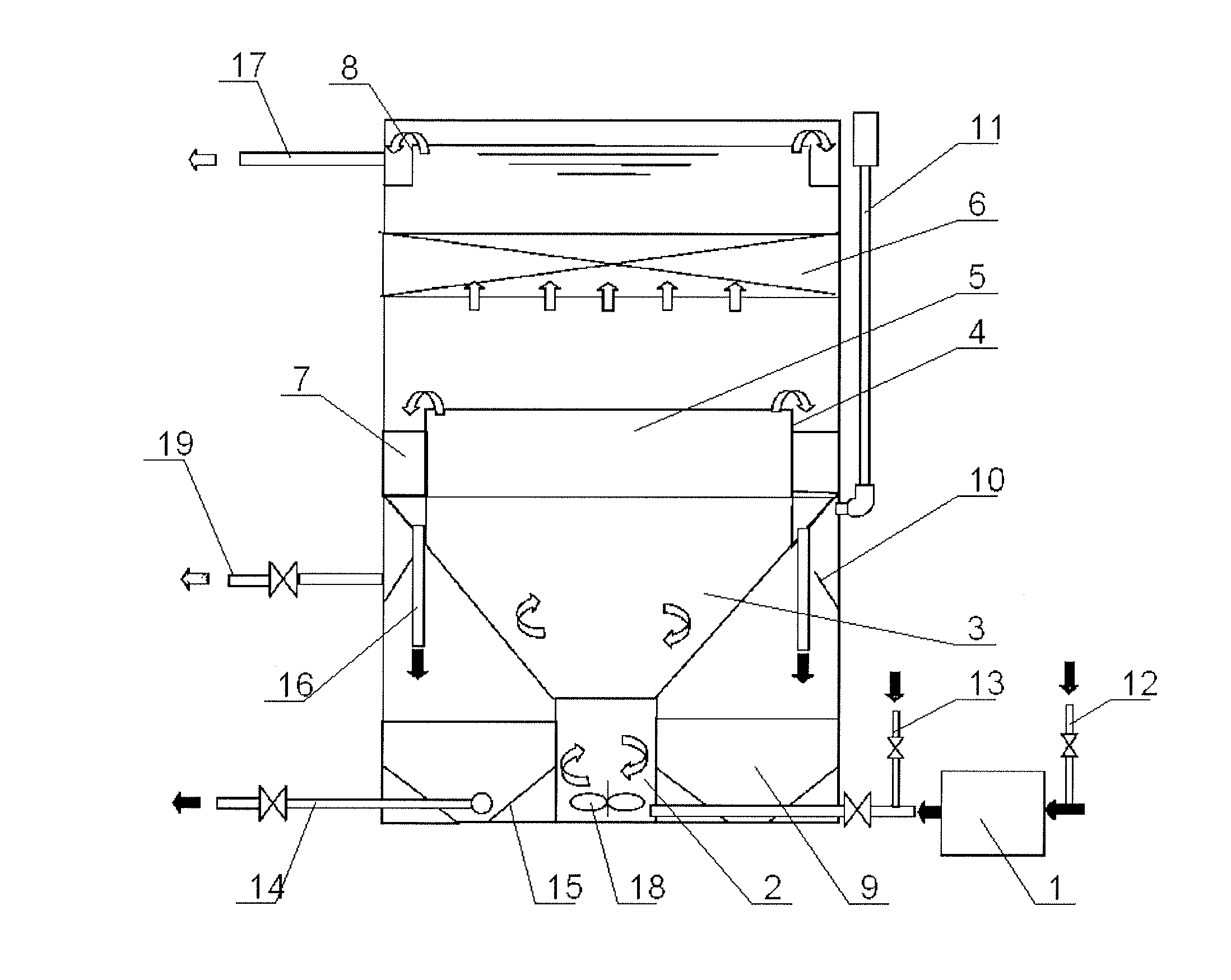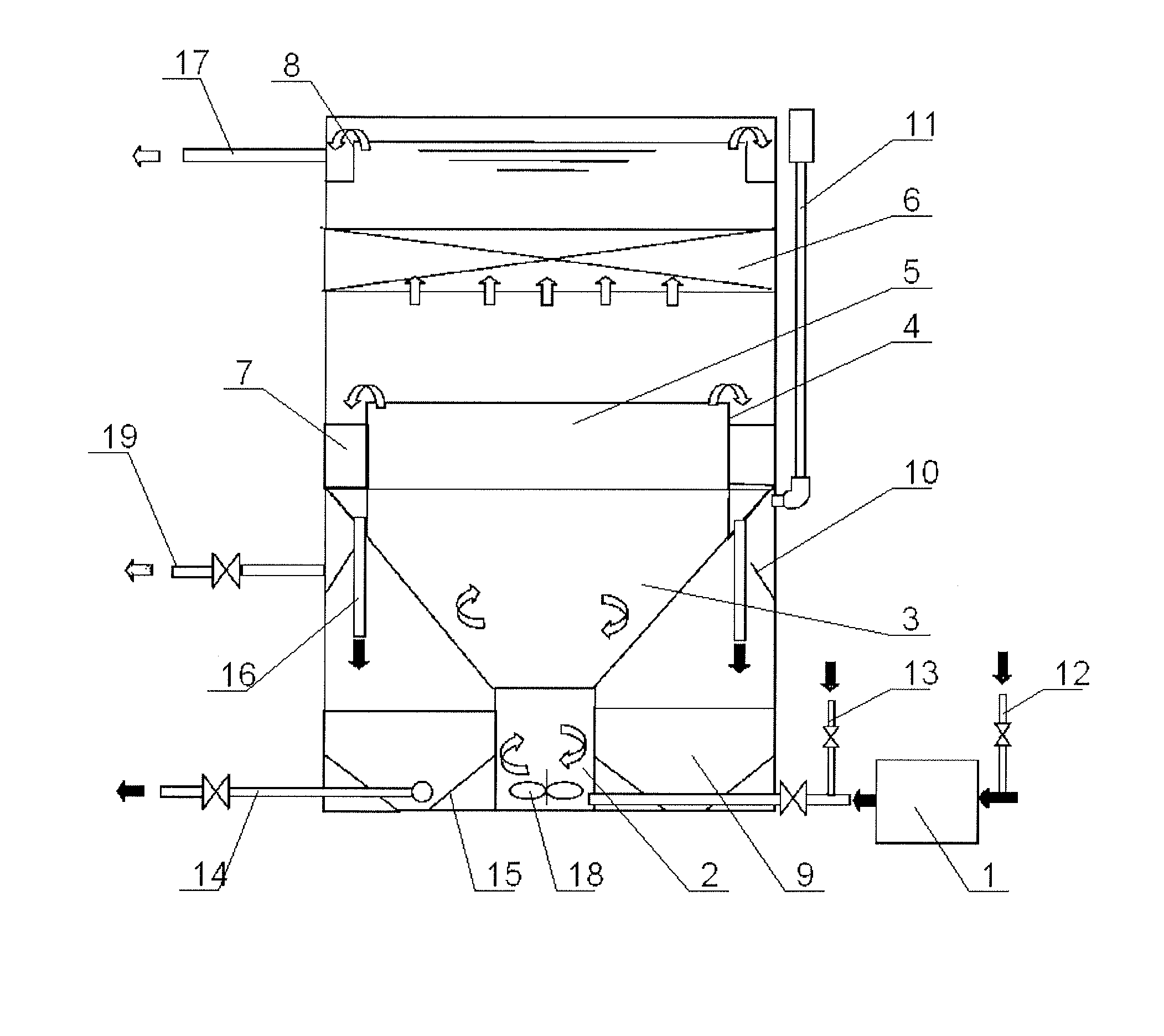[0005]An object of the present invention is to provide an improved device for an oily wastewater purifying system, with a simple but reliable treatment process, low investment and operation costs, low land occupation, and effective solid-liquid separation, in order to overcome the existing drawbacks, such as a long process, a large investment, a low treatment efficiency and complicated operations and management of a filtration tank, that exist in the treatment of oilfield produced water and petrochemical discharged water, and solve the technical problems of pretreatment of oily wastewater from petrochemical enterprises prior to its biological treatment and tertiary treatment after the biological treatment.
[0012]The internal structure of the device in the present application is designed precisely based on the coagulation mechanism. When wastewater added with agent(s) is injected to the bottom of the cylindrical central coagulation reaction tube along a tangent direction, the flow direction of the wastewater is changed significantly due to the particular structure of the cylindrical body of the central coagulation reaction tube. Due to the additional agitation of the agitator, a relatively strong turbulence of the wastewater occurs so that the agent is sufficiently mixed with the wastewater. At this point, sludge particles in the wastewater are within the initial flocculation stage, and the turbulence has an insignificant influence on the flocculation. As the flocculation proceeds, the sludge particles are getting bigger. As the sludge flocculation proceeds to the late flocculation stage, the turbulence has a more and more negative influence on the flocculation. At this point, in favor of the demand of flocculation process, the mixture of the agent and wastewater flows into the reverse cone-shaped cyclone flocculation stage, where the section is getting larger, the flow speed is gradually reduced, and the flowage of the mixture is alleviated. Thus, the flocculation action is substantially completed at the little bottom of the reverse cone-shaped cyclone flocculation stage. The sludge particles after the flocculation have a density that is getting larger as the sludge particles rise, while the flow speed of the mixture is getting lower. Subsequently, sludge particles that are gradually sedimentated are supported and pressed by the rising flow of wastewater continuously inputted from the lower portion of the vertical tank; as a result, the sludge remains stationary when its gravity is equal to the applied support and pressing forces, thereby forming a filtering layer of suspended sludge at the suspended sludge filtering zone. Particles in the filtering layer of suspended sludge are getting bigger as the filtering layer intercepts contaminants carried by the incoming water, and thus have an increasing sedimentation speed, so that the rising speed of water flow and water yield can be improved, and the filtration effect can be achieved.
[0013]The dense filtering layer of suspended sludge is composed of flocs formed from both the suspended solid carried in the wastewater and the coagulant. The lower surface layer of the filtering layer grows thicker increasingly as the flocs move upwards. Further, as a bypass in the tank caused by the filtered water according to hydraulic mechanism flows, sludge of the upper surface layer of the filtering layer of suspended sludge is guided continuously into the peripheral sludge collecting groove, so that the upper surface layer is continuously reduced and gets thinner, and the thickness of the filtering layer of suspended sludge reaches a homeostasis. When the wastewater subjected to the coagulation goes upwards through the filtering layer of suspended sludge, i.e. a filtering layer of flocs, contaminants such as suspended colloid particles, flocs and bacteria thalluses are intercepted within the filtering layer of suspended sludge due to combined forces of interfacial physical adsorption and netting catch, electrochemical characteristics of the filtering layer of flocs, an effect of Van der Waals forces, as well as an effect of mechanical filtration, so that the resultant water has a quality as high as that of water produced from fine filtration. The filtering layer of suspended sludge, which is composed of the flocs and has a high density, has a filtering efficiency fairly higher than that of the conventional filtering using a sand layer. Also, the filtering layer of suspended sludge has a very low head loss (i.e., resistance) caused by the filtration, because it is formed of the suspended sludge, and therefore has a head loss fairly less than that of the conventional filtering using the sand layer, the filtering using micropores or the filtering using a reverse osmosis membrane. Further, the filtering layer of sludge is automatically supplemented by the suspended solid carried in the wastewater during the purification process in addition to being reduced automatically, that is, the filtering layer of sludge is updated continuously, thus maintaining a stable thickness and stable physical and electrochemical absorption capabilities, thereby achieving a stable filtering effect, and eliminating a backwashing process of the filtering material layer and updating and supplementing of filtering materials that are essential in the conventional filtering system.
[0014]The device disclosed in the application is advantageous in that oily wastewater is sequentially subjected to the coagulation reaction and the processes of suspended sludge purification and purified water commutation, by means of the internal structure of the device, so that the purification reaction, flocculation and fine filtration of wastewater and the sludge concentration process are implemented integrally within the tank body of the same device for purifying wastewater. Therefore, the device described in the present application has advantages such as a simple but reliable purification process, low investment and operation costs, low land occupation, less restrict requirements on the wastewater, an improved purification efficiency, and elimination of backwashing of the filtering material layer and pollution of filtering materials, thereby providing a novel way applicable to the reinjection of oilfield produced water and the purification treatment of wastewater of petrochemical enterprises, as well as invaluable social benefits and economical benefits.
 Login to View More
Login to View More 

